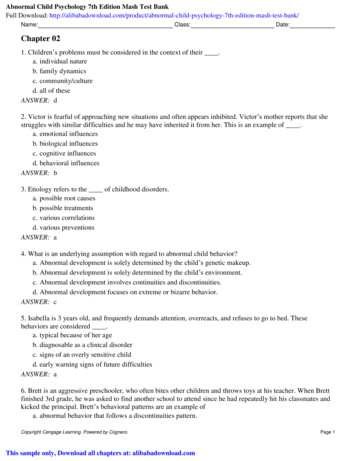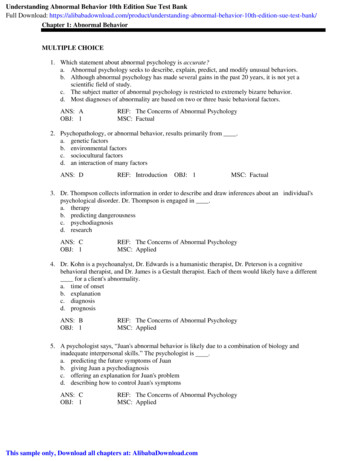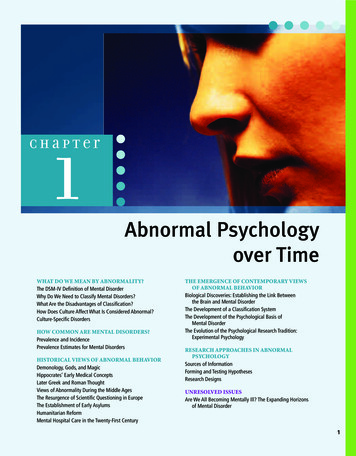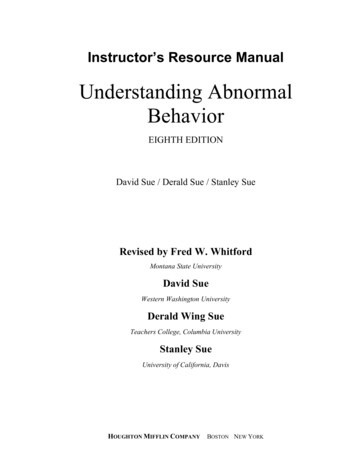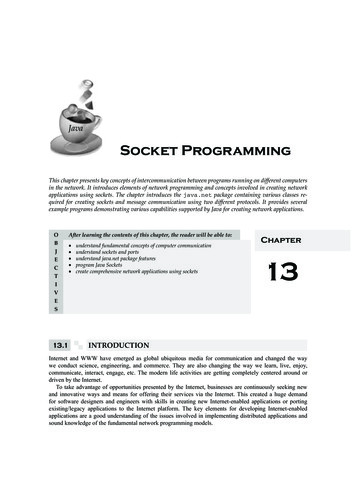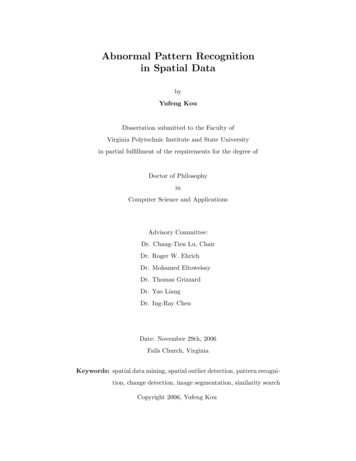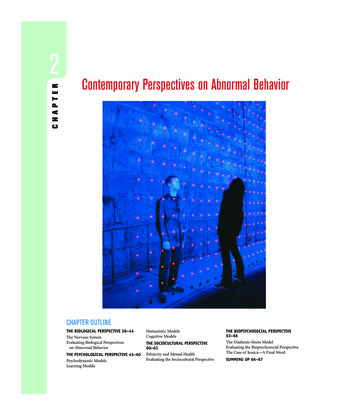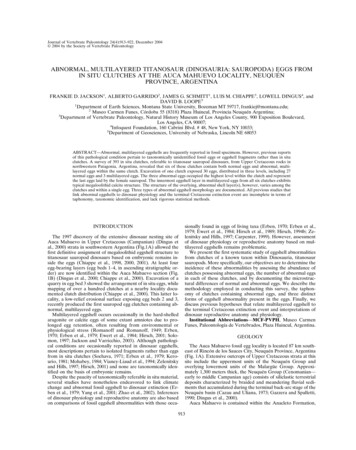
Transcription
Journal of Vertebrate Paleontology 24(4):913–922, December 2004 2004 by the Society of Vertebrate PaleontologyABNORMAL, MULTILAYERED TITANOSAUR (DINOSAURIA: SAUROPODA) EGGS FROMIN SITU CLUTCHES AT THE AUCA MAHUEVO LOCALITY, NEUQUÉNPROVINCE, ARGENTINAFRANKIE D. JACKSON1, ALBERTO GARRIDO2, JAMES G. SCHMITT1, LUIS M. CHIAPPE3, LOWELL DINGUS4, andDAVID B. LOOPE51Department of Earth Sciences, Montana State University, Bozeman MT 59717, frankiej@montana.edu;2Museo Carmen Funes, Córdoba 55 (8318) Plaza Huincul, Provincia Neuquén Argentina;3Department of Vertebrate Paleontology, Natural History Museum of Los Angeles County, 900 Exposition Boulevard,Los Angeles, CA 90007;4Infoquest Foundation, 160 Cabrini Blvd. # 48, New York, NY 10033;5Department of Geosciences, University of Nebraska, Lincoln NE 68053ABSTRACT—Abnormal, multilayered eggshells are frequently reported in fossil specimens. However, previous reportsof this pathological condition pertain to taxonomically unidentified fossil eggs or eggshell fragments rather than in situclutches. A survey of 393 in situ clutches, referable to titanosaur sauropod dinosaurs, from Upper Cretaceous rocks innorthwestern Patagonia, Argentina, revealed that six of these clutches contain both normal eggs and abnormal, multilayered eggs within the same clutch. Excavation of one clutch exposed 30 eggs, distributed in three levels, including 27normal eggs and 3 multilayered eggs. The three abnormal eggs occupied the highest level within the clutch and representthe last eggs laid by the female sauropod. The innermost eggshell layer in multilayered eggs from all six clutches exhibitstypical megaloolithid calcite structure. The structure of the overlying, abnormal shell layer(s), however, varies among theclutches and within a single egg. Three types of abnormal eggshell morphology are documented. All previous studies thatlink abnormal eggshells to dinosaur physiology and the terminal Cretaceous extinction event are incomplete in terms oftaphonomy, taxonomic identification, and lack rigorous statistical methods.INTRODUCTIONThe 1997 discovery of the extensive dinosaur nesting site ofAuca Mahuevo in Upper Cretaceous (Campanian) (Dingus etal., 2000) strata in southwestern Argentina (Fig.1A) allowed thefirst definitive assignment of megaloolithid eggshell structure totitanosaur sauropod dinosaurs based on embryonic remains inside the eggs (Chiappe et al., 1998, 2000, 2001). At least fouregg-bearing layers (egg beds 1–4, in ascending stratigraphic order) are now identified within the Auca Mahuevo section (Fig.1B) (Dingus et al., 2000; Chiappe et al., 2000). Excavation of aquarry in egg bed 3 showed the arrangement of in situ eggs, whilemapping of over a hundred clutches at a nearby locality documented clutch distribution (Chiappe et al., 2000). This latter locality, a low-relief erosional surface exposing egg beds 2 and 3,recently produced the first sauropod egg clutches containing abnormal, multilayered eggs.Multilayered eggshell occurs occasionally in the hard-shelledaragonite or calcite eggs of some extant amniotes due to prolonged egg retention, often resulting from environmental orphysiological stress (Romanoff and Romanoff, 1949; Erben,1970; Erben et al., 1979; Ewert et al., 1984; Hirsch, 2001; Solomon, 1997; Jackson and Varricchio, 2003). Although pathological conditions are occasionally reported in dinosaur eggshells,most descriptions pertain to isolated fragments rather than eggsfrom in situ clutches (Sochava, 1971; Erben et al., 1979; Kerourio, 1981; Mohabey, 1984; Vianey-Liaud et al., 1994; Zelenitskyand Hills, 1997; Hirsch, 2001) and none are taxonomically identified on the basis of embryonic remains.Despite the paucity of taxonomically referable in situ material,several studies have nonetheless endeavored to link climatechange and abnormal fossil eggshell to dinosaur extinction (Erben et al., 1979; Yang et al., 2001; Zhao et al., 2002). Inferencesof dinosaur physiology and reproductive anatomy are also basedon comparisons of fossil eggshell abnormalities with those occa-sionally found in eggs of living taxa (Erben, 1970; Erben et al.,1979; Ewert et al., 1984; Hirsch et al., 1989; Hirsch, 1994b; Zelenitsky and Hills, 1997; Carpenter, 1999). However, assessmentof dinosaur physiology or reproductive anatomy based on multilayered eggshells remains problematic.We present the first systematic study of eggshell abnormalitiesfrom clutches of a known taxon within Dinosauria, titanosaursauropods. More specifically, our objectives are to determine theincidence of these abnormalities by assessing the abundance ofclutches possessing abnormal eggs, the number of abnormal eggsin each of these clutches, and by documenting the microstructural differences of normal and abnormal eggs. We describe themethodology employed in conducting this survey, the taphonomy of clutches containing abnormal eggs, and three distinctforms of eggshell abnormality present in the eggs. Finally, wediscuss previous hypotheses that relate multilayered eggshell tothe terminal Cretaceous extinction event and interpretations ofdinosaur reproductive anatomy and physiology.Institutional Abbreviations—MCF-PVPH, Museo CarmenFunes, Paleontologı́a de Vertebrados, Plaza Huincul, Argentina.GEOLOGYThe Auca Mahuevo fossil egg locality is located 87 km southeast of Rincón de los Sauces City, Neuquén Province, Argentina(Fig. 1A). Extensive outcrops of Upper Cretaceous strata at thissite include the uppermost units of the Neuquén Group andoverlying lowermost units of the Malargüe Group. Approximately 1,300 meters thick, the Neuquén Group (Cenomanian—early to middle Campanian age) consists of siliclastic terrestrialdeposits characterized by braided and meandering fluvial sediments that accumulated during the terminal back-arc stage of theNeuquén basin (Cazau and Uliana, 1973; Gazzera and Spalletti,1990; Dingus et al., 2000).Auca Mahuevo is contained within the Anacleto Formation,913
914JOURNAL OF VERTEBRATE PALEONTOLOGY, VOL. 24, NO. 4, 2004hundreds of exposed in situ egg clutches and the ability to assignthese clutches to their proper stratigraphic unit (egg bed 2 or 3)(Chiappe et al., 2000; Dingus et al., 2000). Clutches on this relatively flat surface typically contain eroded eggs exposed in planview (Fig. 2A). However, dense concentrations of fragmentedeggshells are also present, representing more extensively weathered clutches (Chiappe et al., 2000). The weathered condition ofmost fossil material within the study area necessitates an explanation of the terms and criteria used in this survey.Terms and Criteria Used for Clutch InvestigationIntact clutches previously quarried from egg bed 3 contain upto 35 eggs; each clutch covers an area of approximately onesquare meter (Chiappe et al., 2000). In the study area, differential weathering often exposes eggs in different areas of the sameclutch. Therefore, eggs that are less than one meter apart andseparated by abundant eggshells are considered to belong to thesame clutch. Eggs within these clutches occur in close proximityto one another and the eggshell is oriented vertically in the sediment, preserving a significant portion ( 1 3) of the original eggperimeter in cross section (Fig. 2A). Normal eggs from this locality (some containing sauropod embryonic remains) are approximately 15 cm in diameter, with 1.00 to 1.78 mm-thick megaloolithid eggshell structure (Fig. 2B) (Chiappe et al., 1998). Thesurface ornamentation consists of tubercles ( 1 mm diameter)that occasionally coalesce to form ridges (Figs. 2C). An abnormal egg, therefore, is defined as an egg with an unusually thickeggshell ( 2.5 mm) comprised of two or more superimposedeggshell layers, with rugose, prominent tubercles that are typically greater than 1 mm in diameter (Figs. 2D, 3A–C). Petrographic thin sections and scanning electron microscopy provideverification of initial field identification of abnormal eggs.The SurveyFIGURE 1. The Auca Mahuevo locality. A, geographic location. B,detailed stratigraphic column for the Anacleto Formation and overlyingunit showing positions of egg beds 1–4. C, air photograph of the studyarea showing location of the 6 clutches containing abnormal eggs (P1, P2,P3, P5, P6, P8).which conformably overlies the Bajo de la Carpa Formation. Alow-angle disconformity (Ardolino and Franchi, 1996) occurs atthe contact between the Anacleto Formation and overlyingAllen Formation (Malargüe Group). In the study area, theAnacleto Formation is 85 meters thick (Fig. 1B) and characterized by reddish and reddish-brown mudstones and interbeddedgray-green, thin sandstone bodies. The age of the Anacleto isearly to middle Campanian (Legarretta and Gulisano, 1989), anage recently confirmed from paleomagnetic data (Dingus et al.,2000). Four egg-bearing levels occur within the mudstone andfine-grained sandstone facies interpreted as overbank deposits ofa distal fluvial plain (Dingus et al., 2000). Two egg layers, eggbeds 3 and 4, extend laterally for up to eight kilometers. Smallroot traces, caliche nodules, and abundant slickensided surfacesindicate paleosol development and relatively abundant vegetation on the floodplain. Arid climatic conditions, with pronouncedseasonal alteration of wet and dry conditions, characterize deposition of the Neuquén Group (Garrido, 2000).METHODS AND MATERIALSA randomly selected site ( 38,000 m2) was chosen within thelarger Auca Mahuevo study area after field reconnaissance (Fig.1C). Criteria used for site selection included the presence ofSystematically spaced, parallel transects approximately onemeter apart were conducted within the 38,000 m2 study site.Each clutch was examined for characteristics described aboveand then marked in order to avoid duplication. Sedimentologicaland taxonomic attributes were documented for each site thatexposed a clutch containing abnormal eggs. These clutches werephotographed and eggshell samples from normal and abnormaleggs were removed for laboratory analysis. To calculate the areaof the study site, five-meter long cross marks were spray paintedon the ground and the area was photographed from a smallairplane. Each clutch was located on the aerial photograph andassigned to the appropriate stratigraphic layer (Fig. 1B, C). Toconserve the fossil material, only one clutch containing abnormaleggs was excavated. This clutch was mapped using a 1 m2 gridand graph paper and the trend and plunge of slickenlines weremeasured with a Brunton compass and noted on the map.Laboratory AnalysisEggshell fragments from normal and multilayered eggs fromall six clutches were ultrasonically cleaned and half of the specimens were prepared as standard petrographic thin sections (30!m thick) and studied by transmitted and polarized light microscope. The remaining specimens were gold coated (10 nm),mounted on aluminum stubs, and imaged under a J. R. Lee Instrument Personal SEM and/or JEOL 6100 SEM with Backscattered Electron Imaging (BEI) capabilities, coupled to a NoranVoyager Energy Dispersive X-ray (EDX) system. Structural attributes (shell thickness, pore width) were measured with BuhlerOmnimet Enterprise image analysis software. Two partial eggscollected from clutch P-6 (MCF-PVPH-514) and all eggshell
JACKSON ET AL.—ABNORMAL TITANOSAUR EGGS915fragments are catalogued in the Museo Carmen Funes, PlazaHuincul, Province of Neuquén, Argentina.RESULTSTaphonomyFIGURE 2. Abnormal and normal egg and eggshells. A, weatheredabnormal, multilayered egg from clutch P1 (MCF-PVPH-251) exposedin cross section. Arrows show double eggshell and maximum eggdiameter. Scale bar equals 10 cm. B, petrographic thin section of eggshell from an egg with normal megaloolithid calcite structure fromP-5 (MCF-PVPH-254) showing preserved stratified membrane beneath the interior shell surface. Note membrane thickness and nucleation sites at the outer membrane surface. Triangles denote pores thattraverse the membrane; arrow marks eggshell dissolution and replacement by calcite. Scale bar equals l mm. C, D, surface of normaland multilayered eggshell, respectively, from clutch P-5 (MCF-PVPH254). Note the more rugose surface ornamentation in D. Eggs areadjacent to one another and subject to similar weathering. Scale barsequal 1 cm.Exposures of egg bed 3 produced 329 in situ egg clutcheswithin the 35,000 m2 study area; five of these clutches containboth normal and abnormal eggs. Fourteen clutches, one of whichcontains a multilayered egg, are present in the more limitedexposures of egg bed 2 (3,000 m2). Since other clutches are unexcavated, the total computed number of eggs (normal and abnormal) (Table 1) represents a minimum number present andadditional eggs may remain undetected in the substrate. Thefollowing general description applies to all clutches presentwithin the study area, followed by a more detailed description ofa nearly complete clutch (P-6) excavated from egg bed 3.General Clutch Description—The weathered clutches fromegg beds 2 and 3 preserve normal and abnormal eggs exposed inplan view (Fig. 2A) and occur in similar sandy, reddish brownmudstone. The sediments surrounding these clutches exhibit nolithologic evidence of nest structure (see Chiappe et al., 2004),and the condition of the eggs prior to burial (intact or hatched)remains uncertain in all clutches except P-6, discussed below. Inclutches containing more than one multilayered egg (P-3, P-6,P-8), the eggs are adjacent to each other, rather than separatedby normal eggs. A narrow (1–2 cm) blue-green “halo” outlinesthe exposed eggs, indicating chemical reduction of the sedimentimmediately surrounding the egg, possibly the result of decomposition of the contents after burial. Occasionally, small ( 3 mm)calcium carbonate nodules are aligned along the egg perimeter,replacing portions of missing eggshell. Clutch P-5 represents theonly clutch with associated bone: immediately down slope froma normal egg, an unidentified bone fragment adheres to a small( 1.5 cm) piece of normal eggshell. No additional bone was present in the vicinity.Clutch P-6—In the steeper terrain of the southwest portion ofthe study area, egg bed 3 crops out 3.3 meters above the base ofa slope and approximately one meter below a horizon containingsmall ( 1.0 cm) caliche nodules. The laterally continuous exposures of egg bed 3 produce dense concentrations of eggshell oneto three meters apart along the contour of the hill. Most of theseconcentrations exhibit eggshells with normal surface ornamentation. However, abundant multilayered eggshells with rugosesurface morphology cover the slope immediately below two partially eroded, abnormal eggs (Fig. 3A–D). Surface collection onthe slope beneath these two eggs produced 382 fragments ofmultilayered eggshell and only 14 single-layer fragments. Oneegg (P-6-2) exhibits missing portions of the outer abnormal shell,exposing normal eggshell beneath the abnormal layer (Fig. 3A,C). These 14 normal specimens, therefore, most likely representeggshell that separated from the abnormal, multilayered egg during recent weathering.Excavation of the clutch revealed a total of 30 eggs, 27 normaleggs and 3 multilayered eggs with rugose surface ornamentation(Fig. 3D). The eggs are distributed in three levels within theclutch; the three abnormal eggs occur at the highest level, inclose proximity to one another (Fig. 3D). Both normal and abnormal eggs in P-6 contain concave-down eggshell fragments,indicating that whole eggs were crushed by lithostatic compression. The narrow blue-green “halos” surrounding the eggs resemble those present in the other five clutches and elsewhere inegg bed 3. Diagenetic growth of gypsum crystals within this zonefacilitates rapid weathering of the fossil material. Mudstone surrounding and filling the eggs shows relatively abundant parallelstriations (slickenlines), with varying orientations (Fig. 3D) andone to several centimeters of vertical offset, as determined by
916JOURNAL OF VERTEBRATE PALEONTOLOGY, VOL. 24, NO. 4, 2004TABLE 1. Summary of taphonomic and structural information for six clutches containing abnormal, multilayered eggs. Where more than oneabnormal egg occurs in a clutch, the eggs are distinguished by sequential numbering.ClutchEggbedTotal no.of eggsAbnormaleggsEgg 335430511213213–15 cm13 cm12–15 cm12–17 cm8–15 cm10–12 cmnormalrugoserugoserugoserugoserugosefield measurements using a Brunton compass and a centimeterruler, respectively.Discussion of P-6 Taphonomy—The absence of nearly anynormal eggshell on the slope below this clutch suggests that recent erosion was limited to the abnormal eggs occupying thehighest level within the clutch. The number (30) and distributionof eggs in P-6 typifies other intact clutches previously excavatedfrom egg bed 3 (Chiappe et al., 2000), and the three egg levelsrepresent the maximum number of superimposed eggs yet documented at this locality (unpublished data). Clutch P-6, therefore,most likely represents a complete, in situ clutch. Burial and preservation of the eggs, like other clutches from egg bed 3, resultedfrom suspension settling of fine-grained material during a floodevent (Chiappe et al., 2000).The highly variable orientation of slickenlines on the surfaceof the mudstone results from vertisol development within thenesting horizon (Chiappe et al., 2000). In a seasonally wet anddry climate, repeated shrinking and swelling occurs in high claycontent soils. During the rainy season the clay expands andblocks of soil shear off and slide past each other under pressure,producing striated surfaces (Brady and Weil, 2002). The presence of slickensides inside some eggs indicates that vertisol de-StructuraltypeII, II, IIIII, IIIII, IIIIIII, IIIComments——P-3-1 & P-3-2 exhibit III & II, respectively—present in all 3 eggspresent in both eggsvelopment occurred (or continued) after burial and subsequentinfilling of the eggs by sediment. Pedogenesis undoubtedly produced compaction and displacement of some eggs within thisclutch. However, movement was typically no more than a fewcentimeters, based on field measurements of offset rock surfaces,suggesting minimal change in the original egg orientation anddistribution.The level at which the abnormal eggs occur and their closeproximity to each other in clutch P-6 is significant. Some extantturtles produce more than one clutch in a season. Occasionally,one or more eggs are retained in the oviduct and additionaleggshell layers are deposited over the eggs with shelling of thenext clutch. These retained eggs represent the first eggs laid withsubsequent oviposition. Ewert et al. (1984) suggested that if dinosaurs produced multiple clutches in a single season, one mightexpect to find retained eggs at the bottom of the clutch. Although a reasonable hypothesis, the presence of the three abnormal eggs at the highest level in clutch P-6 indicates that theyare the last eggs laid by the female sauropod. Although multilayered eggs also occur adjacent to each other in unexcavatedclutches (P-3 and P-8), no assessment is possible of the level atwhich they occur.FIGURE 3. An excavated clutch, P6 (MCF-PVPH-514). A, B, eggs P-6-2 and P-6-3, respectively, two eroded abnormal eggs that occupied thehighest level in the clutch. Scale bars equal 1 cm. C, enlargement of double eggshell layers indicated by box in A. Note difference in diameter intubercles of the inner and outer eggshell layers. D, field map of clutch P6 showing location of three multilayered eggs. Dip symbols indicate directionof slickenlines on egg and rock surfaces.
JACKSON ET AL.—ABNORMAL TITANOSAUR EGGSMicroscopic Analysis of EggshellDiagenesis—Scanning electron microscopic (SEM) imagesand petrographic thin sections of eggshells from the six clutchesoften show soft tissue preservation in the form of eggshell membrane. Embryonic integument (Chiappe et al., 1998) and eggshellmembrane (Grellet-Tinner, 2002) previously reported fromother eggs in this study area further support this interpretation.In the six clutches containing abnormal eggs, permineralizedeggshell membrane is present at the base of some eggshells (Fig.2B) and occasionally separates the multiple layers in abnormaleggs (Figs. 4A, B). In addition, freshly broken eggshell from themultilayered egg in clutch P-5 exhibits an 860 !m-long feature(9 !m thick) that consists of two intertwined strands that appearto flatten before entering an opening in the calcite eggshell (Fig.4C–E). Elemental analysis shows no quantitative difference incomposition between the calcite eggshell and the permineralizedstrand. This structure may represent permineralized protein matrix, an organic latticework on which the calcite mineral is deposited during eggshell formation. However, differentiating fossilized contaminants such as bacteria or fungi from the proteinmatrix of the original eggshell remains problematic because oftheir similar morphology (Jackson et al., 2002).In all specimens, diagenetic dissolution of eggshell calcite tookplace primarily between individual shell units at the interior eggshell surface and, less frequently, within the upper portion of theFIGURE 4. Soft tissue preservation. A, B, SEM image of multiple shelllayers and preserved membrane in P-8–2 (MCF-PVPH-255). C, SEMimage of multilayered eggshell (MCF-PVPH-254). Arrow marks the location of permineralized strand shown in D and E. Scale bar equals 1mm. D, upper portion of strand shown in C as it enters an opening in theeggshell calcite. Scale bar equals 10 !m. E, enlargement of fibroustwisted structure shown in C. Scale bar equals 10 !m.917shell (Figs. 2B, 4C, 5A, B). Reprecipitation of sparry calciteaccompanied this diagenetic alteration in most specimens. Authigenic analcime replacement often occurs in association withthe protein membrane (Figs. 5A–E, 6A), suggesting that themembrane was preferentially susceptible to analcime replacement. Identification of the zeolite mineral is based on crystalmorphology in thin section and SEM images (Fig. 5C) and energy dispersive xray (EDX) analysis of individual crystals.Eggshell Microstructure—All normal, single-shelled eggsfrom the six clutches exhibit megaloolithid eggshell structure(Fig. 2B) identical to eggs from egg bed 3 that contain titanosaursauropod embryos (Chiappe et al., 1998, 2001). Abnormal eggsfrom all six clutches display an unusually thick shell comprised ofsuperimposed eggshell layers (Figs. 3A–C, 4A–C, 5A, 6A–C).The inner eggshell shows similar thickness, calcite microstructure, and surface ornamentation to normal sauropod eggs fromthis site. However, the additional abnormal layers vary in number and structure (Fig. 6A–C). This variation occurs within andamong the six clutches and even within a single egg. The outersurface of all multilayered eggs displays rugose ornamentation,except for the abnormal egg in clutch P-1 that exhibits normalornamentation. Table 1 summarizes three types of abnormalmorphology (Types I–III) documented in the multilayered eggsand provides additional data from the six clutches. When morethan one abnormal egg is present in a clutch (e.g. P-8), the eggsare sequentially numbered: P-8-1, P-8-2.Type I Morphology—This type of abnormal eggshell morphology exhibits two superimposed eggshell layers, both withnormal megaloolithid structure and thickness (Fig. 6A) (Chiappeet al., 1998). Occasionally, remnants of permineralized membrane that separates the superimposed eggshell layers exhibitnucleation sites comprised of radiating calcite spherulites. Undercrossed polars in petrographic thin sections, these spherulitesexhibit pseudouniaxial crosses and extinction occurs simultaneously in both eggshell layers when the microscope stage isturned (Fig. 6A). Where more extensive diagenetic replacementoccurs, these nuclei comprised of radiating crystals “float” withinauthigenic analcime crystals between the eggshell layers (Fig.5D, E). These calcite nucleation sites are lateral to one another,at a consistent distance above the unweathered surface of theunderlying eggshell (Fig. 5D).Type II Morphology—The inner eggshell exhibits normalstructure, while the outer eggshell is typically thinner and lackscalcite nuclei (Figs. 4C, 5A, 6B, 7A, B). Calcite crystals are“seeded” to the underlying eggshell, with or without visiblemembrane separation. The base of the abnormal layer closelyconforms to the tuberculate surface ornamentation of the underlying egg (Figs. 5A, 6B) and the calcite structure of the abnormaleggshell maintains the established crystal orientation. Undercrossed nicols in thin sections, a sweeping extinction pattern extends through both the inner and outer eggshell layers simultaneously in some areas, indicating optical continuity between thetwo eggshells (Fig. 7B). However, where multiple shell units ofthe inner eggshell correspond to a single shell unit in the outereggshell layer, the extinction pattern may be disrupted.Type III Morphology—This structure consists of three ormore superimposed eggshell layers (Figs. 4A, B, 6C, 7C, D). Theinnermost eggshell exhibits normal calcite structure and ornamentation. The abnormal layers follow the contour of the underlying shell, displaying a smooth basal contact, and an absenceof calcite nucleation sites. In some areas of the abnormal egg inclutch P-2, the second and third abnormal layers display smalltubercles on the outer shell surface (Fig. 7C, D). Remnants ofmesh-like permineralized membrane often separate the calcitelayers (Figs. 4A, B, 6C). Occasionally, the additional shell layersblock pores that traverse the inner eggshell, thereby restricting gas exchange to the embryo (Fig. 6C). Shell units compris-
918JOURNAL OF VERTEBRATE PALEONTOLOGY, VOL. 24, NO. 4, 2004ing the outermost eggshell terminate in broad ( 1.0 mm),rounded tubercles, producing rugose surface ornamentationcompared to normal eggs exposed within the same clutch (compare Fig. 2C to D).DISCUSSIONOccurrence of Eggshell AbnormalitiesModern amniotes that lay hard-shelled eggs include some geckos and turtles and all crocodilians and birds. Egg abnormalitiesin these taxa occasionally result from egg retention, often inresponse to physiological or environmental “stress.” Such stressmay result from absence of appropriate nesting substrate or material (Ewert et al., 1984; Hughes et al., 1986), handling, oviductobstruction (Asmundson, 1933), disease or injury (Romanoffand Romanoff, 1949), diet (Grau and Kamei, 1949), and highpopulation density (Ferguson, 1985; Solomon, 1997). With prolonged egg retention, additional eggshell layer(s) may be deposited over the first eggshell (Romanoff and Romanoff, 1949; Erben et al., 1979; Kérourio, 1981; Ewert et al., 1984; Jackson andVarricchio, 2003).With the exception of turtles, documentation of abnormal,multilayered eggshell in extant amniotes is very limited. Erben etal. (1979) reported this multilayered condition in an unidentifiedcrocodilian egg; however, the paper lacks citation, photographs,and description of the egg or eggshell microstructure. Some birdsoccasionally produce abnormal, superimposed eggshell layersthat are similar in structure to abnormal dinosaur eggshells (Solomon, 1997; Jackson and Varricchio, 2003). However, reports ofmultilayered avian eggs are rare. In contrast, multilayered eggsare relatively common in some hard-shelled turtle eggs, currentlyreported in at least nine extant species (Cagle and Tihen, 1948;Erben, 1970; Erben et al., 1979; Ewert et al., 1984; Schleich andKästle, 1988).Multilayered dinosaur eggshells are reported from Upper Cretaceous rocks of Asia, Europe, and North and South America(Dughi and Sirugue, 1958; Thaler, 1965; Erben, 1970; Sochava,1971, Mohabey, 1984; Zhao et al., 1991; Vianey-Liaud et al.,1994; Powell, 1987; Zelenitsky and Hills, 1997; Ribeiro, 1999;Zhao et al., 2002). Reports of intact, multilayered eggs includeonly three isolated eggs from different localities in Maastrichtianrocks of southern France (Kérourio, 1981) and a single egg fromthe Jurassic Morrison Formation in Utah (Hirsch et al., 1989).Jackson et al. (2002) reported a multilayered fossil turtle eggfrom the Judith River Formation of Montana, and Schleich andKästle (1988) reported multilayered gecko eggs from the Oligocene of Germany. Although present in a variety of fossil eggshell types, the multilayered condition is most frequently reported in the megaloolithid eggshell structure (Hirsch, 2001).Abnormalities in Titanosaur EggsFIGURE 5. Diagenetic eggshell alteration. A, SEM image of abnormaleggshell from P-8–2 (MCF-PVPH-255). Arrow indicates area of membrane replacement by analcime. Scale bar equals 1 mm. B, elementalmap of inner eggshell of same egg with outlined areas indicating analcime replacement in the membrane area of the inner eggshell. Scale barequals 1 mm. C, close up of analcime crystal morphology. Scale barequals 10 !m. D, E, black arrows point to calcite nucleation sites surrounded by authigenic analcime in laterally adjacent sites in P-1 (MCFPVPH-251) and between the inner and outer eggshell in P-2 (MCFPVPH-252), respectively. Note the distance from the surface of the innereggshell to the nucleation site, denoting approximate thickness of theformer membrane. White arrow in D indicates closely spaced nucleationsites at base of inner eggshell, compared to more widely spaced nucleation sites at the base of the overlying outer eggshell. Scale bars in D andE equal 1 mm and 100 !m, respectively.In extant taxa, eggshell abnormalities provide information onthe timing of stress (Tyler and Simkiss, 1959; Hughes et al., 1986;Solomon et al., 1987; Solomon, 1997; Jackson and Varricchio,2003). Fossil eggshells provide similar information: in all abnormal eggs from the six sauropod clutches, the inner eggshell iscomparable in thickness, microstructure, and surface ornamentation to normal titanosaur eggs from the Auca Mahuevo locality. Therefore, the adverse stimuli that resulted i
eggshells are also present, representing more extensively weath-ered clutches (Chiappe et al., 2000). The weathered condition of most fossil material within the study area necessitates an expla-

